The following article is a combination of our three-part series on the origins of the alphabet.
Here’s a crazy proposition for you: You evidently understand English, since you are reading this article; I’ll wager, then, that you can read ancient Hebrew text—the script used in biblical times.
If, however, you only understand modern Hebrew (again, obviously not the case, since you are reading this article), I’ll wager that you cannot read ancient Hebrew.
Let me qualify that. *You, the English speaker, can recognize—even roughly sound out—the letters of ancient Hebrew (rather than understand the language).
It might sound ridiculous at first. But our English alphabet is a closer match to the ancient Hebrew alphabet than the modern Hebrew alphabet is. The same applies to the virtually identical Latin alphabet, the Cyrillic alphabet, the Greek alphabet. Of course, our English words for various things are completely different from the Hebrew. But the alphabet we use, and the sounds the letters make, is quite similar to the ancient Hebrew alphabet.
Let’s do a little exercise. Here are three English phrases, but spelled with their related, ancient Hebrew letters (mirroring or rotating some of the letters slightly, but not changing their shape at all). Can you read them?
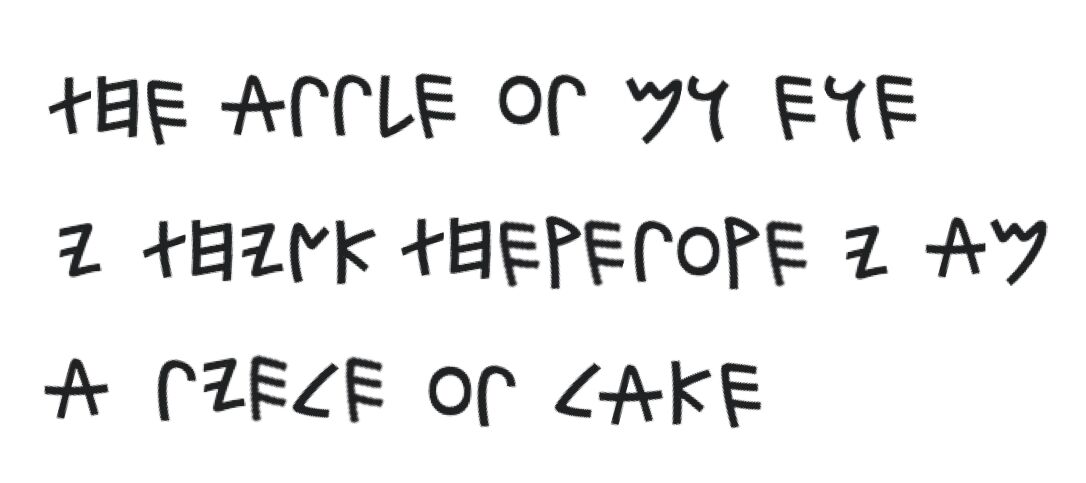
(Here’s a hint—don’t focus in on each individual letter—“step back” and view each sentence as a whole.)
“The apple of my eye.” “I think, therefore, I am.” “A piece of cake.” Did you get all of them? Then congratulations—you can “read” (or rather, “sound out”), ancient Hebrew! (Probably the trickiest letter was the “p”—“p” and “ph/f” are the same in Hebrew. Again, the exercise is somewhat of an oversimplification—based solely on related individual letters, rather than proper pronunciation of the words as a whole.)
The question, then, is this: How did our English letters come to resemble the ancient Hebrew script so closely? Here’s a pretty good table showing the historical transmission in briefest form—note the “Phoenician” line, second from the top:
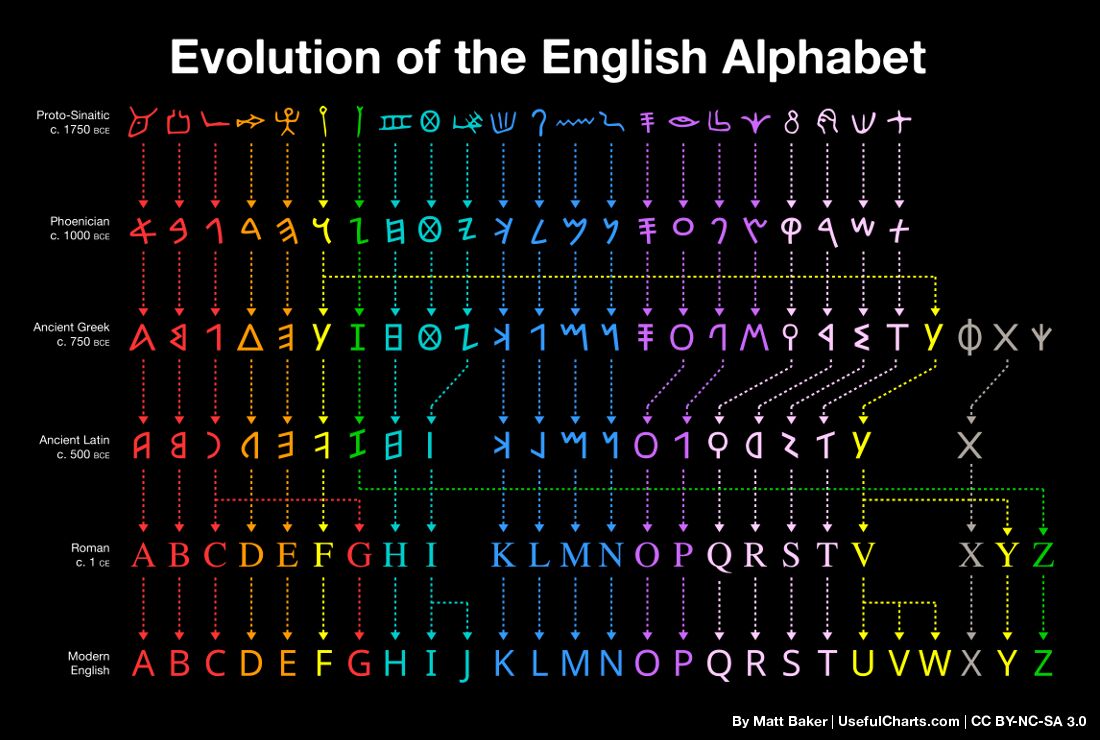
This second line contains the letters of our above exercise. These Phoenician letters are one and the same as the ancient Hebrew. In fact, the script is often called “Hebrew-Phoenician,” or even simply, “Hebrew.” A strong case has been made that this script began with the Hebrews and was then passed on to the Phoenicians. See the top, “Proto-Siniatic” line, that predates it? This was a script belonging to a Semite community working as slaves in Egypt—dating to roughly the same period as the Israelite captivity.
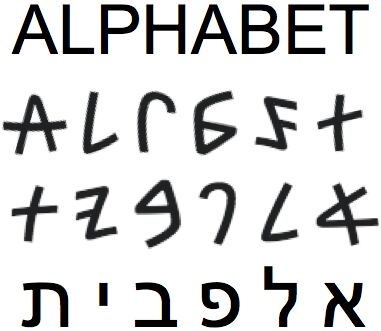
The modern Hebrew script, on the other hand, followed a very different evolution: After the circa 586 b.c.e. destruction of Jerusalem, the alphabet transformed dramatically, with Aramaic taking hold on the region (the lingua franca of the Babylonian Empire—the book of Daniel is written nearly entirely in Aramaic). It is from this Aramaic “evolution” that both the modern Hebrew- and Arabic-style scripts derive. The Hebrew script changed again around the turn of the millennium into what is known as the rabbinic Hebrew script, not far removed from modern Hebrew—revived in the 19th century into common use by lexicographer Eleazar ben-Yehuda. And while modern Hebrew words are the same, or related to, their ancient Hebrew counterparts, any connection between the alphabets is almost unrecognizable.
So, again, the question: How—and why—did the ancient Hebrew-Phoenician alphabet become the basis of our English language? How did the very same writing system of the ancient Israelites become the most widely used writing system in the world today? After all, there are over 5 billion active users of the various alphabet derivatives from Hebrew-Phoenician (as shown on the map below)—accounting for nearly 70 percent of the world population!

Was It Phoenician Influence? Or Israelite?
Let’s cover the past nearly 3,000 years in a short paragraph. The British Empire, from the 19th to 20th centuries, was the largest empire the world had ever seen—hence why we all speak English. We took our alphabet from the earlier Roman Empire—their Latin alphabet. The Italians of old were in love with ancient Greek culture—an “affair” known as Hellenism—and based their alphabet on the one used by the prior Greek Empire. Over the course of these roughly 3,000 years of history, impressively little has changed about our alphabet given the great length of time. But where, how and from whom did the Greeks get it?
If you’ve skimmed one or two articles or textbooks, you may assume that the Greeks, who originally used a completely different Mycenaean alphabet (actually a “syllabary” known as Linear B), adopted their new “Classical” alphabet from the Phoenicians around the ninth century b.c.e. The Phoenicians were a small coastal nation, essentially paralleling the borders of modern-day Lebanon (though perhaps smaller, and more limited to the coastal edge), known for trade throughout the Mediterranean in the first millennium b.c.e. As such, they are credited with the transmission of the alphabet to the Greeks, who evidently loved the simple idea of the 22-letter, one-sound-for-each-symbol alphabet, rather than the radically complex syllabaries of the day (Linear B had nearly 200 symbols, depending on how you count them).
But what is the level of evidence these conclusions are based on? Is the classic “Phoenician” response really the right one?
It’s no secret that modern academia has a bias against Israel, the significance of the ancient Israelite and Judahite kingdoms, their impact on the surrounding regions, and the biblical account. This bias meant scholars were “surprised” to find that literacy was widespread in ancient Judah. That when an Assyrian inscription was discovered mentioning King Ahab of Israel with a force of 10,000 soldiers and 2,000 chariots, “scribal error” was assumed. This bias led one famous Israeli archaeologist to admit to Haaretz, “In the past, archaeological evidence has often been stretched to fit the biblical narrative, so researchers today tend to reject any such possible link out of hand” (emphasis added).
Should the possibility of a Hebrew transmission of their alphabet to ancient Greece be “rejected out of hand” as well? Calling the original Classical Greek alphabet “Phoenician” or even “Phoenician-Canaanite” may sound more sophisticated and academic (never mind that from this Iron Age period, far more artifacts with Hebrew script have been discovered than Phoenician, Canaanite, Moabite, Ammonite and Edomite combined—all ancient nations that used the same alphabet). Is the convention justified? Is the jury in on this subject?
Is there any more evidence for a Hebrew transmission to the Greek world—and thus, to ours?
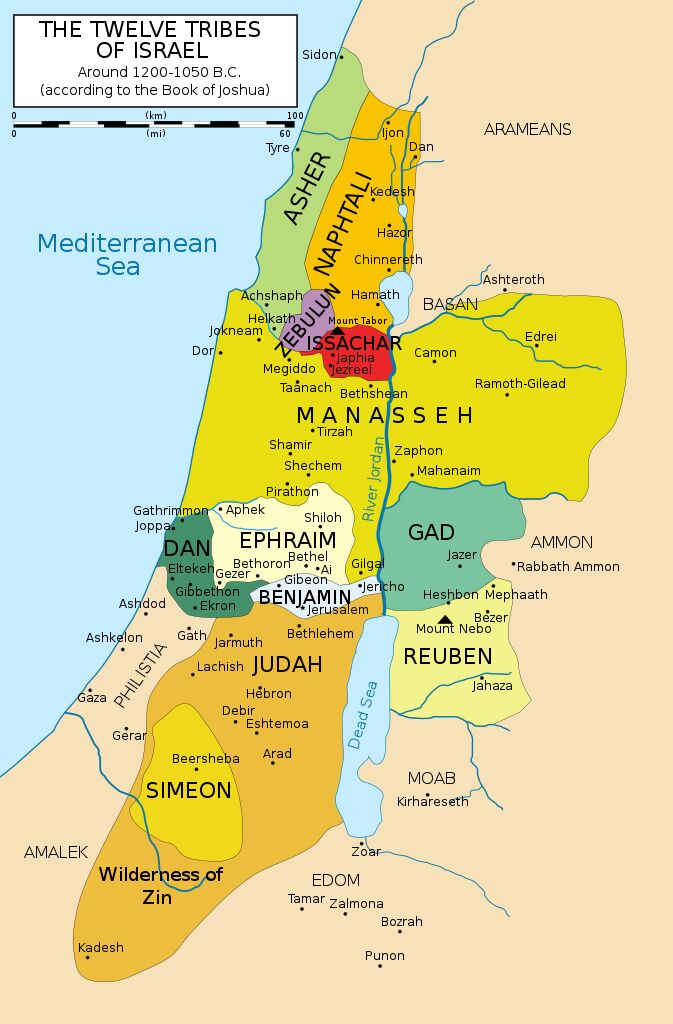
Actually, very little is known about the Phoenicians. Scholars still don’t even agree on who these people were, whether or not they were distinct from the Canaanites or “other residents” of the Levant—namely, the Israelites. (There is even a position that the Phoenicians were Israelites, since much of the Phoenician territory was part of the tribe of Asher, as described in Joshua 19:24-31—see map, right). Another theory is that it was a “melting pot” region, which at least included an Israelite population. (As the Bible repeatedly brings out, it was not unusual for the early Israelite tribes to “go rogue.”)
It may come as a surprise that the term “Phoenicians” is nowhere found in the Hebrew Bible. Instead, the Bible references separate city-states, such as Tyre and Sidon. (You might remember the story of King Hiram of Tyre, who aided King David in building his palace and King Solomon in building the temple.) This is backed up by the historical record. There is a marked lack of evidence that even the Phoenicians viewed themselves as a single nationality—city-states regarded as “Phoenician” (such as Tyre, Sidon, Byblos and Carthage) were politically independent of each other and were multi-ethnic cities.
The Phoenicians are actually regarded as a “lost” civilization—ironically, due to a lack of written records! Yet this was the great trading empire thanked for laying the “economic, political and cultural foundations of Western civilization”—and that gave the world the alphabet?
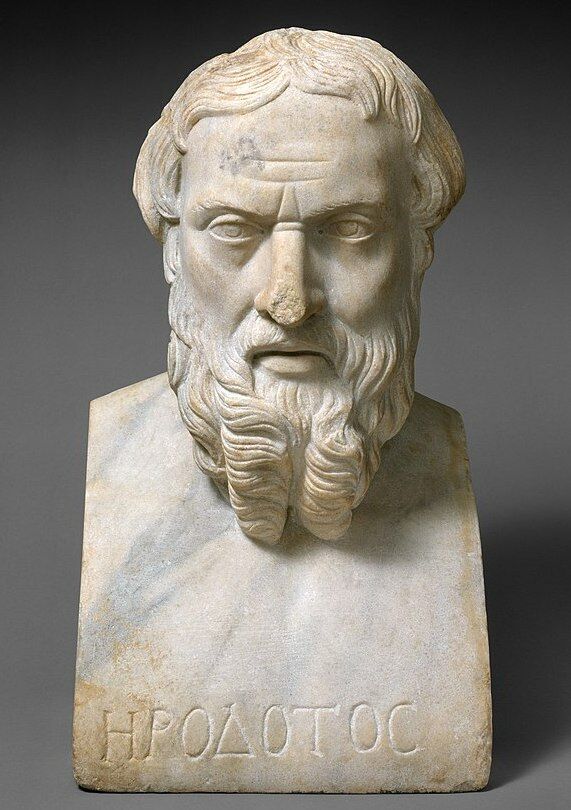
Some evidence for a Phoenician transfer of the alphabet comes from the fifth-century b.c.e. Greek historian Herodotus. He wrote that a mythical Phoenician king called Cadmus was responsible for passing on the alphabet to the Greeks. Herodotus’s position, however, is completely undermined by his statement that Cadmus ruled 1,600 years before his lifetime—around 2100 b.c.e. This is at least 1,000 years before the Greeks adopted the alphabet—even long before the proto-Siniatic development of it. (An unsurprising statement, though, given some of Herodotus’s extremely skewed, nationalistic writings.)
Much more about the Phoenicians is known from the middle-to-late first millennium b.c.e. But what about the crucial early 11th-to-8th century period, within which the alphabet was transferred to the Greeks? Was ancient Israel at this time merely a small, insular nation that had no real impact on its neighboring nations—let alone the wider Mediterranean?

A Differing Opinion
Dr. Larry S. Milner (md, jd, mls) has compiled a large amount of research on the close ties between the ancient Israelites and the Greeks. He writes in his lengthy work, humorously titled Was Achilles a Jew?:
Since ancient times, the Phoenicians have been credited with providing this input [of Semitic words into the Greek language], and this concept carried over into the modern era, as reflected in the conclusion of the Italian scholar Sabatino Moscati that “there is no doubt that the Phoenicians taught the alphabet to the Greeks.” Although most linguists have placed this merger in the eighth century b.c.e., recent evidence has convinced some authorities that the Phoenician contribution may have taken place as early as 1100 b.c.e., a time when the Greek mainland was entering the Dark Age following the Trojan War. This dating would also be consistent with a Hebraic, rather than a Phoenician, input ….
But Milner is not the first to put forward this suggestion. Actually, he was preempted by nearly 2,200 years. He continues:
A Hebraic contribution, rather than a Phoenician origin for the inclusion of Semitic words in the Greek language, was first suggested by the Hellenistic Jewish historian Eupolemus (second century b.c.e.), who concluded that the Phoenicians received their language from the Jews and then transmitted their script to the Greeks.
Again, there is a close similarity of the Phoenician, Hebrew and Canaanite alphabets—around the start of this first millennium b.c.e., the alphabets are virtually indistinguishable. But some clues may indicate the transmission of a specifically Hebrew alphabet to the Greek world at this time. Milner continues: “[R]ecent scholarship has supported this view by showing that the Hebrew modification of doubling up three of the letters to be used as vowels (h, w, y) may have been used as a basis for the Greek and Latin alphabets.”

Bishop Eusebius of Caesarea (third century c.e.) noted the same thing—linking the origin of the Greek alphabet directly to the Hebrews, rather than the Phoenicians, based on the specific letter styles. (He also believed that the alphabet used to create the Hebrew Scripture was transferred by God to the Greeks, for the purpose of crafting the Greek New Testament.)
A semantic debate about letter style and order could go (and has gone) on and on. The fact is, the Phoenicians were a known trade entity, as the Bible itself brings out (note especially Ezekiel 27). Is there any historical framework for an Israelite connection with the Greek world—one in which an alphabet could have been transferred?
Dan, Asher and Greece
Here’s a fact that may come as a surprise: The Bible jointly describes Israelite and Greek merchants. Specifically, Israelites of the tribe of Dan. “Dan also and Javan going to and fro occupied in thy fairs …” (Ezekiel 27:19; King James Version). “Javan” is the biblical name for Greece. This passage references numerous national and tribal polities. Evidently, there was some apparent connection between Dan and Greece at this time in a seafaring, trading environment.
This chapter is, of course, from a later biblical period (circa seventh century b.c.e.). But there is another, much earlier reference to a seafaring tribe of Dan.
Some 600 years earlier, the Israelites were embroiled in a battle against the northern Canaanites (during the time of the judges). At the end of the victorious battle, criticism is leveled at certain of the Israelite tribes who did not show up to fight. “[W]hy did Dan remain in ships? Asher continued on the sea shore, and abode in his breaches [ports]” (Judges 5:17; kjv). For some reason, the seafaring Danites were out in their ships—the Hebrew word referring to large, long-distance vessels. What were they doing in the Mediterranean right at the initial period that evidence suggests the alphabet—or at least certain Semitic words—began to make their way into Greece? The Asherites—who were allocated much of the “Phoenician” territory—were also criticized for staying and manning their sea ports.
Besides the textual clues, archaeological discoveries have also shown a close link between the Israelites—again, specifically the Danites—and Greeks. Excavations at Dan’s “capital” in Israel, Tel Dan, have revealed a heavy Greek influence on the Danite population: Greek-style objects of worship, Greek weapons, Greek burial.

A Danite connection with the Greek world is not a new theory. The late, great Israeli archaeologist Yigael Yadin posited a connection between the Danites and a still mysterious seafaring “Denyen” people, who lived in a north-Levant territory called “Danuna” (in an area later regarded as “Phoenician”). The Greek poet Homer wrote of a seafaring group called Danaan whose ships joined the Greeks in the battle against Troy (roughly dating to the same time as the Judges 5 battle, in which Dan was criticized for being away in his ships). And even ancient Irish histories record the migration to Ireland of a Mediterranean group they called Tuatha de Danann (tribe of Danann), a tribe that had been constantly embattled with the Philistines (note the 11th-century c.e. work Lebor Gabála Érenn). Whose biblical territory bordered Philistia? The tribe of Dan. And remember the story of Samson and the Philistines? He was a famous Danite judge.
That the Danites would sail as far as Ireland some 3,000-plus years ago might seem outlandish. But remarkably, archaeological evidence even for this back-and-forth travel, between the British Isles and Israel, also exists! In a 2017 study, chemical analysis of tin ingots discovered in Haifa revealed that they were mined in Cornwall, England, before being shipped to Israel. And these are not late-era artifacts. These ingots date to the 13th to 12th centuries b.c.e.—the general early period described above and the start of the period in which evidence suggests the Hebrew-Phoenician alphabet began to be picked up in the Greek world.
Note that the major port of Haifa is also in the territory of the tribe of Asher. What did the Prophetess Deborah complain about to the Asherites in Judges 5? Remaining in their ports—receiving and facilitating trade, apparently including “British” tin imports such as this. (Deuteronomy 33:24-25 also link the Asherites with the metal industry.)
The deep connections between the Israelites and the Greek world, as well as general trade, are numerous. Some even believe that the Hebrew word for traders, such as the Danites—Haroclim—was picked up as the name for the Greek myth of Heracles (Hercules)—given the numerous similarities between the Greek strongman and the Danite Samson. Both killed a lion with their bare hands. Both were responsible for the death of their first wives in a fire. Both singlehandedly wiped out armies. Both faced off against enemies fielding giants. Both are known for their signature use of clubs as weapons. Both are associated with “multiheaded” canines, as well as snakes. Both drank water that miraculously came from a rock. Both tore down the gates of a city. Both had a weakness for women. And both unwittingly met their demise at the hands of a lover identified as a “man-destroyer” who betrayed them—Samson by Delilah, Hercules by Deanirah. The examples could go on. And surprise, surprise—according to the Greeks, Hercules was of the Danaan line.

Just coincidental connections? But there are numerous other examples of early Israelite stories that directly parallel early Greek history and symbolism—such as the serpent-entwined “symbol of healing” (read more about this here). Evidently, certain Israelite history was incorporated into early Greek myth. If even Israelite stories were adopted by the Greeks, is it unreasonable to believe that they also could have adopted the alphabet?
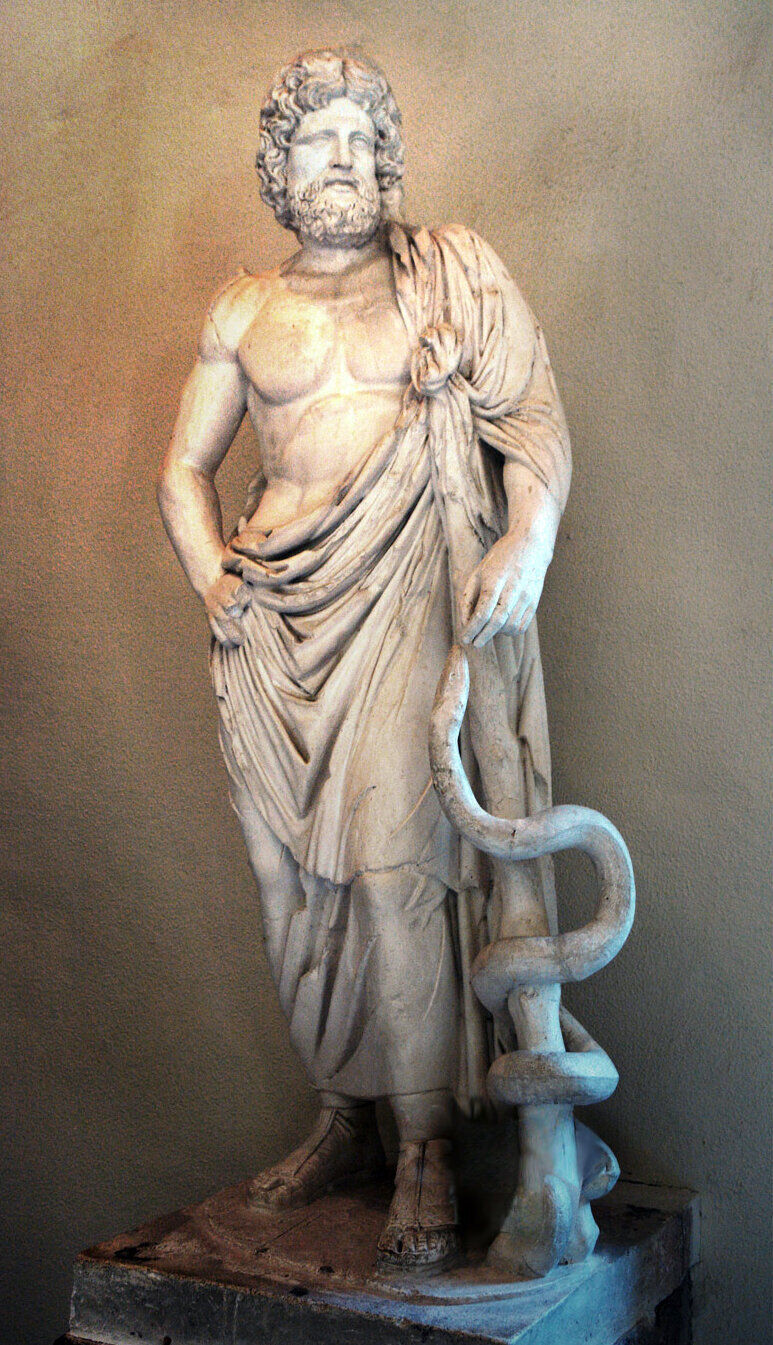
But the Israelite connections with the Greek world run deeper than mere goods and stories—even a familial link is attested to.
King Areus I: Spartans ‘Brothers of the Jews’
In the third century b.c.e., King Areus i of Lacedemonia (the official name for the Spartan territory of southwest Greece) wrote a letter to the Jewish ruler Onias i. The short message read as follows:
Areus, King of the Lacedemonians, to Onias, sendeth greeting:
We have met with a certain writing, whereby we have discovered that both the Jews and the Lacedemonians are of one stock, and are derived from the kindred of Abraham. It is but just therefore that you, who are our brothers, should send to us about any of your concerns as you please. We will also do the same thing, and esteem your concerns as our own, and will look upon our concerns as in common with yours. Demoteles, who brings you this letter, will bring your answer back to us.
A number of interesting theories exist as to how this familial connection was “discovered” by the Spartans—including links to Israelites from the tribes of Dan or Simeon (read more about this subject here). There is literary evidence to suggest a strong Danite presence in Greece itself—particularly in Achaea (where a “Danaid” dynasty was established; ironically, Herodotus’s Cadmus was also from this area). Whatever the answer, the above is an example from the Greek world of the close nature of the Israelites—in blood, as well as in alphabet. Again, is a namely Hebrew transmission of the alphabet to the Greek world so impossible?
A Philistine Microcosm
But wouldn’t it be great if there were some kind of litmus test to indicate an Israelite transmission of the alphabet? Perhaps an independent, breakaway population from the Greek isles migrating to the shores of Israel sometime just before the 11th to eighth centuries b.c.e., and during this same period readily adopting the alphabet of their neighboring Israelites?
As it turns out, such a thing exists.
The Philistines had long been suspected of immigrating to the Holy Land from the Greek isles. Indeed, the Bible points to the largest Greek island, Crete, as their point of origin. But it was only last year that dna analysis provided corroboration for this, pointing to a major Philistine migration from Crete that evidently happened around the 13th to 12th centuries b.c.e.
To date, few Philistine inscriptions have been found, and the Philistine language remains a mystery. Scientists do not know what language the Philistines came to Israel with (and Crete is known for its undeciphered writing systems). The earliest-known Philistine inscription dates to the 10th century b.c.e.—and this inscription (pictured below) and all following Philistine inscriptions are written in the Hebrew-Phoenician alphabet. This, in a proud nation-state firmly encircled by ancient Israel—separate from Phoenician territory.

Evidently, these Philistines adopted the Hebrew-Phoenician alphabet sometime during or prior to the 10th century b.c.e. They had distinctly different, Philistine words and names (known from the Bible as well as inscriptions), pointing to an original Indo-European language, but by this point were transliterating them into the Hebrew-Phoenician alphabet. It seems that besides the alphabet, the general language of the neighboring Israelites was also adopted—although there were apparently still significant differences centuries later (as shown in Nehemiah 13:23-25).
Perhaps all this sounds peculiar. Weren’t the Philistines a fiercely aggressive, warlike society, constantly fighting Israel? Why would they so “readily” adopt the alphabet? Actually, the biblical and archaeological picture is far more multi-layered. dna analysis shows that the Philistines came to be genetically mixed with the local populations. And the Bible describes not only wars, but also alliances, friendships and marriages.
Perhaps the Philistines received the alphabet from native Canaanites. Or perhaps from the Phoenicians. But interactions between these groups are hardly described, if at all—and conversely, ancient texts are awash with descriptions of Philistine-Israelite interaction. And that counts for something.
So within our 11th-to-8th century “alphabet transfer period,” we see the full adoption of the Hebrew-Phoenician alphabet by a smaller “Greek” community alongside Israel, with the use of the alphabet as early as the 10th century b.c.e. Is it just coincidence that this occurred around the same time as the wider Greek world’s adoption of the same alphabet?
But what may have been the real catalyst for the adoption of this alphabet at this time period? And a spreading of the alphabet not only to Greece—but to numerous other surrounding Near Eastern countries during the 10th century b.c.e., ultimately culminating in the worldwide use of alphabet systems today?
Effect of Empire
Back to the present day. English is the language of international communication. It’s the global language of business. It’s essentially the language of the Internet. If you want to travel anywhere, you’ll be best off knowing English. Why does “everyone” speak English?
In short, it is thanks to the power, influence, dominance and education of the British Empire.

Around the same time the British Empire was growing, the Dutch were a powerful trading nation, with a network of seaports and coastal domains all around the world (up until 2004, Rotterdam was still the busiest port in the world.) Perhaps you can think of the Dutch as the Phoenician traders with their port cities. But we don’t all speak Dutch. Chances are, if you’re an English speaker and you’re reading this—which you obviously are—you know more German, French, Spanish or even Mandarin than Dutch! (Even the largest territories held by the Dutch—most notably Indonesia—do not list Dutch as an official national language.) It takes empire, power, prosperity and influence over vast territory to effect sweeping change.
Such was the British Empire, which at its peak controlled a land area equivalent to the moon. Such was the Roman Empire, from whom we adopted our alphabet. Such was the Greek Empire, from whom the Romans adopted theirs.
So, within the 11th to eighth centuries b.c.e.—the time frame in which scholars believe the Hebrew-Phoenician alphabet was adopted by the Greeks—was there any other powerful “empire” on the scene that could have acted as a catalyst for the Greek adoption of their writing system?
There was: an Israelite “empire.”
The Language of Solomon
King Solomon reigned for 40 years during the critical 10th century b.c.e.—the heart of the “alphabet transfer” period and when the Hebrew-Phoenician alphabet became much more standardized. You’ve probably heard the biblical account of Solomon’s extraordinary wealth and riches.
Long has the debate raged as to whether or not Solomon existed, let alone the size, scope, wealth and power of Israel at the time. (Nonetheless, if scholars can put an admittedly “lost civilization” of Phoenicia on a pedestal based on minimal archaeological evidence and heavy reliance on later textual evidence, then the same can be done for Solomon’s kingdom. Actually, a slew of new discoveries are emerging that attest to the biblical depiction of Solomon’s reign—but that’s another story.)
Solomon’s kingdom, according to the biblical account, was renowned far and wide. Solomon’s temple, covered in gold, was a wonder of the ancient world—in today’s money, the value of the gold has been estimated at roughly $300 billion (₪1 trillion—Israel’s current gross domestic product is about ₪1.3 trillion). Leaders and representatives traveled from far and wide to pay their respects to the king, to see his kingdom, and to test his unmatched wisdom.
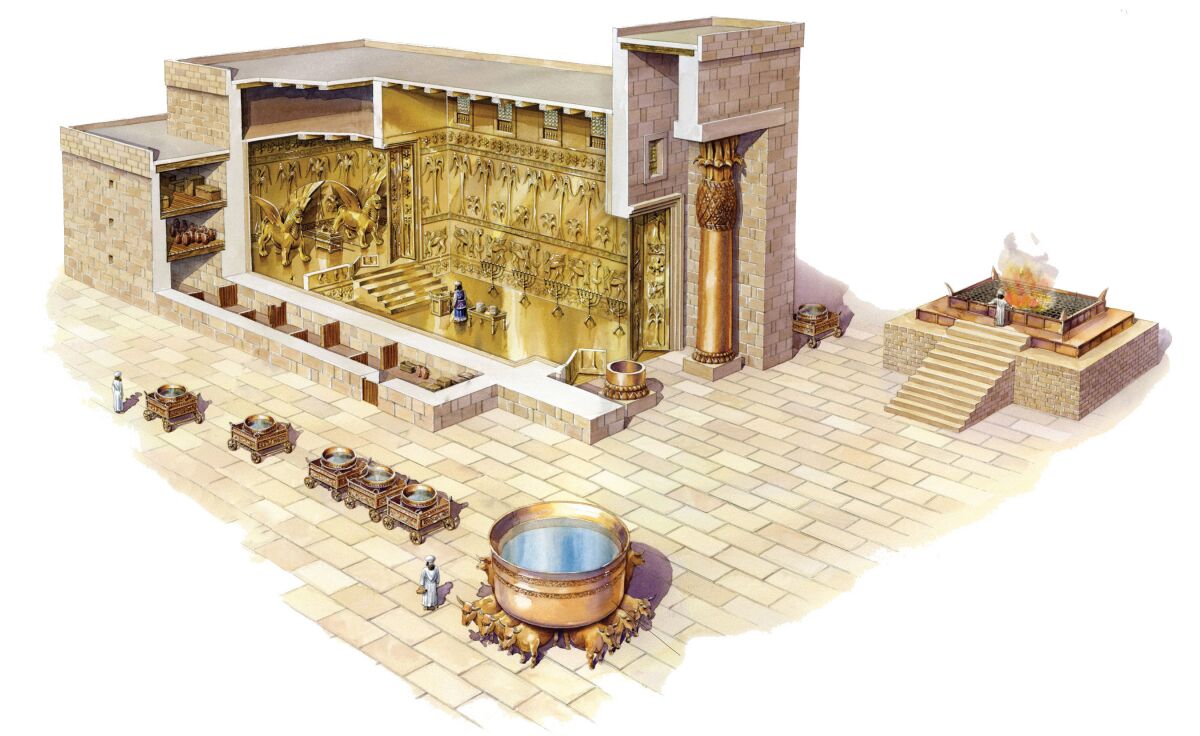
According to the biblical account, 10th-century b.c.e. Israel became literally awash in gold and other riches. Solomon became heir to his father’s newly conquered and massively expanded territory in the Levant, including land in Lebanon and Syria (e.g. 1 Kings 9:19), and likely much of the territory in the Sinai Peninsula. Not only did David and Solomon rule over the Israelite kingdom, they also directly reigned over other surrounding “kingdoms” (1 Kings 5:1). All Canaanites in and around the region—perhaps even as far away as Turkey (the seat of Hittite dominion)—were tributary (1 Kings 9:20-21).
Solomon also had a first-class merchant navy that sailed around the known world, bringing him gold, silver, ivory, apes and peacocks. His fleets were divided between the Red Sea in the south and the Mediterranean Sea to the west (verses 26-28; 1 Kings 10:22-23). Solomon became a major arms dealer and a merchant man, importing goods from Egypt, and selling chariots and horses to kingdoms as far north as Turkey (verses 28-29).

Famously, Solomon married 700 wives from far and wide, which in those days meant political connections—connections to Egypt, Moab, Ammon, Edom, Zidon, Turkey, etc (1 Kings 11:1-3). The Bible states that everyone—from the Ethiopians to the Zidonians to the Arabians—“all the kings of the earth” brought gifts of all types to Solomon (2 Chronicles 9:14, 23-24)—including most famously the queen of Sheba, who undertook a grueling weeks-long journey to Israel by a “very great train” (probably by camel; 1 Kings 10:2). The Bible affirms that the “riches and honor” of Solomon were unmatched by any king during his lifetime (1 Kings 3:12-13). Silver was so common that it became worthless (2 Chronicles 9:20, 27).
[A]nd his fame was in all the nations round about. … So king Solomon exceeded all the kings of the earth in riches and in wisdom. And all the earth sought the presence of Solomon, to hear his wisdom, which God had put in his heart. (1 Kings 5:11, 10:23-24)
Some would conclude that the Bible is simply being overly dramatic. Surely Israel could not have had more riches, power—even influence on the world around them—than the mighty Assyrians, Hittites, Babylonians, Egyptians. But here, remarkably, the archaeological record provides matching geopolitical context for the biblical account!
A ‘Period of Chaos’
This fantastic Israelite “empire” lasted nearly a century from David through to the start of the reign of Solomon’s son Rehoboam (circa 1011–930 b.c.e.). And it fills precisely a notable void in the remarkably mysterious 10th-century b.c.e. period of geopolitics.
The Egyptian empire had fallen during the Bronze Age Collapse, never to rise to the same heights of power. Virtually all eastern Mediterranean kingdoms had likewise collapsed and were languishing during this period. The powerful Hittite empire (which controlled much of Turkey) had collapsed. The Middle Assyrian empire had ended—they were now in a 150-year gap before the start of their “Neo” empire (which started, interestingly, just after Solomon’s reign). Likewise, the Babylonian Empire was in their own 100-year window termed the “Period of Chaos” (likewise ending just after Solomon’s reign). And the Greeks were in what is known as the “Dark Ages”—a mysterious period from which they would suddenly emerge with a new alphabet matching the one used by Israel.
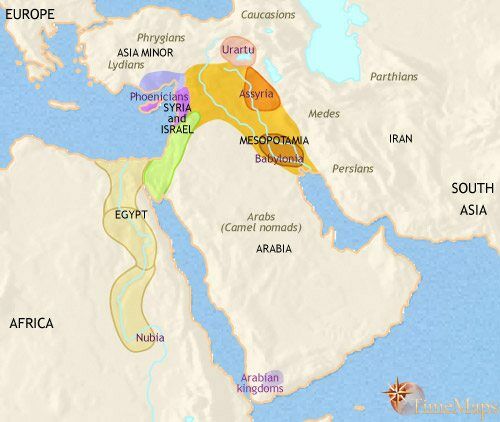
What power, then, filled the gaping void? History isn’t the story of century-long vacuums of power.
The Bible describes an Israelite empire at this time, even dominating these faraway “period of chaos” Mesopotamians. 1 Chronicles 18-19 enumerate David’s conquests and expansion of territory, including his defeat of the Philistines, Moabites, Arameans, Syrians, Edomites, Ammonites, Amalekites, Mesopotamians and a number of smaller entities.
Despite the popular academic bias, could the biblical account of a superb Israelite empire—which happens to slot perfectly into this precise timeframe and geopolitical situation—be the answer to this power vacuum? An empire with strong ties to the Greek world—a Greek world which finally emerged from its “Dark Ages” with similar stories and alphabet as its then-powerful, dominant, influential, even related Israelite “brothers”? Could the glory and dominance of Solomon’s empire be primarily responsible for the spread of the alphabet to Greece?
We can glean further evidence for this, not from Greece, but from everywhere else.
It’s (Not) All Greek to Me
The Hebrew-Phoenician alphabet did not spread around this time to just Greece—it went literally everywhere.
A prime example is the ancient South Arabian script, which archaeological discoveries show was on the scene by at least the ninth century b.c.e. This script was used in Ethiopia and the southern territories of the Arabian Peninsula, and is the forerunner of the modern Ethiopian Amharic script. But how was this South Arabian script received? These polities were far separate from the Phoenician state. In fact, scientists don’t say it was derived from the Phoenician script at all—instead, classifying it as derived from the centuries-older Proto-Siniatic script (of course, no mention of Hebrew influence).

The record is indeed silent about Phoenician connections with Ethiopia during this early period. But it is awash with Ethiopian connections to Israel. To this day, 3,000 years later, Ethiopians still hold dear to their Solomonic ties and the story of the establishment of their royal line from Solomon. The Bible takes pains to detail the queen of Sheba’s arduous journey to visit Solomon, the good relations between the two nations, and the close connections with other Arabian states, which brought Solomon tribute. Again, is it coincidence that they all ended up with an alphabet directly related to Israel’s, roughly around this period?
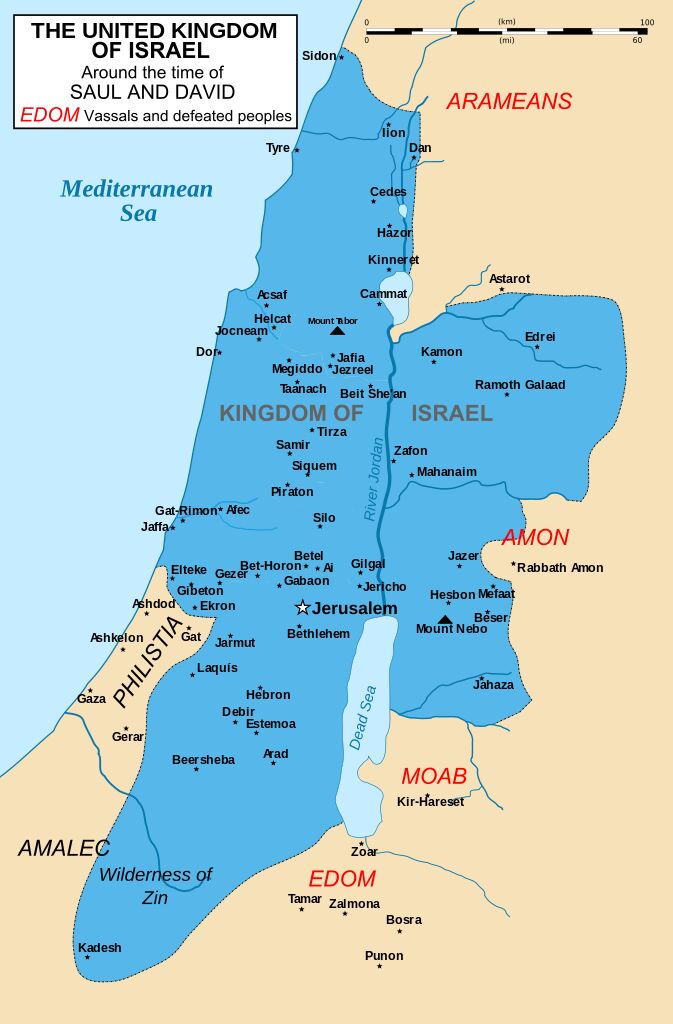
Putting aside Ethiopia and the southern Arab states, one does not need to look far from Solomon’s kingdom to see the literal flowering of the use of the alphabet by surrounding nations on all sides of Israel. Take a look at the map to the right, from the time of Saul and David (even at this size, Israelite territory wasn’t yet at its full Solomonic extent). Why is it that every nation surrounding Israel—the Arameans in the northeast, the Ammonites in the east, the Moabites in the southeast, the Edomites in the south, the Philistines in the southwest (as for the Amalekites, there are no yet known inscriptions), the Greek isles to the west, as well as the Phoenicians in the north—why did they all adopt and standardize the same Hebrew-Phoenician alphabet, beginning roughly around this time period? Sure, the Phoenicians were known sea-traders. But what about the distant, overland Moabites, Edomites, Ammonites, Arabians—and further afield Ethiopians and southern Arab states? What about, as we covered in part two, the Philistines who migrated from Greece and adopted the alphabet of their surrounding neighbors?
Note also the words in red. These were, as the map shows, “vassals and defeated peoples” by Israel (including, later, the Amalekites and Philistines). It should be unsurprising, then, that these would receive the alphabet at this time from the Israelites, rather than the far distant Phoenicians.
Did the Israelites and Phoenicians, then, coincidentally find themselves in the business of spreading the alphabet around at exactly the same time—the Phoenicians by sea, and the Israelites overland? Or was there a singular driving force—an Israelite “empire,” that led the way—and that led the Phoenicians to use the same alphabet? As the second-century b.c.e. historian Eupolemus wrote, it was the Phoenicians who received their alphabet from the Israelites, not the other way around.
And why might that have been?
An ‘Age of Enlightenment’
The Bible does not just describe David and especially Solomon’s empire as one of wealth and power. It describes it as one of literary renown!
King David is credited with “penning” most of the book of Psalms, and King Solomon with three other books of the Bible (Proverbs, Ecclesiastes, Song of Songs). 1 Kings 5:12 attributes to Solomon a total of “three thousand proverbs,” besides songs. The same passage describes Solomon’s wisdom (including, undoubtedly, his writings) as excelling “the wisdom of all the children of the east, and all the wisdom of Egypt.
For he was wiser than all men … and his fame was in all the nations round about. … And there came of all peoples to hear the wisdom of Solomon, from all kings of the earth, who had heard of his wisdom. (1 Kings 5:10-11, :14)
That “counsel” and “knowledge” came in the form of writing, as well as speaking (e.g. Proverbs 20:22). And besides kings David and Solomon, 1 Chronicles 25:8 highlights the presence of “teachers” and “scholars” in Israel during this time.
The book of Ecclesiastes specifically emphasizes Solomon’s teaching—including the heavy emphasis on the written word. Passages reference Solomon’s search for just the right words, “and that which was written uprightly” (12:10). At the end of his life, a weary Solomon related the following:
[F]urthermore, my son, be admonished: of making many books there is no end; and much study is a weariness of the flesh.
With the above Scriptures, then, we have biblical affirmation of the renown of Hebrew literature and wisdom in the 10th century, and its spread far and wide around the known world. And at this same time in secular history and archaeology, we see the adoption of the same Hebrew alphabet by countries surrounding Israel and beyond—the very countries identified in the Bible as having close contact with Solomon’s kingdom. We also see the standardization of the Hebrew-Phoenician alphabet at this point in time—in Israel and in Phoenicia. Is it a stretch, then, to consider that these all were the result of the same phenomenon: the literary influence of a Solomonic empire?
One final, theological point. The glory, extent and influence of Solomon’s kingdom is highlighted in the Bible as a model of the World to Come. And a unique, linguistic phenomenon is attributed to this future world, as seen in Zephaniah 3:9 (King James Version):
For then will I turn to the people a pure language, that they may all call upon the name of the Lord, to serve him with one consent.
This world will witness the spread of a single, pure language. Is it any surprise that Solomon’s world—a type of the one to come—saw the spread of a single Hebrew alphabet, one that is now used in some form or another by 70 percent of the world’s population?

Our Israelite Alphabet
The question of who gave the alphabet specifically to the Greeks—and therefore to us—is still open to debate (as is even the Israelite nature of the Phoenicians themselves). But as we have examined, there is a solid weight of evidence pointing to an early Israelite transmission of the Hebrew alphabet—in spite of traditional labels as “Phoenician” and “proto-Canaanite.” (And when those titles are impossible—as for the Ethiopian and Arabian Peninsula—then “proto-Siniatic.”)
But at its core, the question about the transmission of the alphabet to Greece (and thus to us) is really a side story. Because evidence points to the Israelites as being responsible for the very creation of the proto-Siniatic alphabet that fathered them all.

As mentioned in the first part of this article series, the proto-Siniatic alphabet was discovered among a slave Semitic community working in Egyptian mines. This enslavement matches with the period of the biblical slavery of the Israelites in Egypt. Further, this script was discovered in an area of the Sinai matching a key part of the biblical Exodus story. Debate rages as to the translation of this script—Prof. Douglas Petrovich identifies a number of biblical settings and personalities, including Asenath, Ahisamach and even Moses. (Read more about all of this here.)
Are the Phoenicians known for their enslavement in Egypt, before migrating northward into the Levant? Are the “proto-Canaanites” remembered continually for their suffering in Egyptian labor camps? Perhaps the “proto-Sinaites,” before the flourishing of their language in the Levant? Of course not. It is the Hebrews. The weight of evidence must be followed—and the weight of evidence points to a Hebrew alphabet.
And why was their new alphabet such a hit—why did it spread further into nearly every country on Earth today? Why does nearly every country, excepting a handful of Asian nations, use this alphabet system as a basis for their various languages—from English to Russian to Swahili?
Simplicity.
The ancient alphabet of the Hebrews was revolutionary for its simplicity. One simple sound for one simple symbol—and only 22 of them. In an ancient world of complex hieroglyphs and syllabaries, with hundreds of different symbols to learn (and which only a dedicated scribal few could read), “proto-Siniatic” really was the working man’s language—a literal “language of the slaves” that anyone could readily become educated in and use. (So it probably is no wonder, then, that experts recently discovered literacy to be widespread among the ancient Israelites.)
It’s another story for another day, but what was the language spelled out by this radical new alphabet? A Semitic language. And where does the earliest Semitic language trace? The Akkadian-Babylonian empire, of southeastern Mesopotamia. And what was one of the primary cities of this empire? Ur. You can theorize for yourself how the Semitic language migrated west to the land of Canaan.
All in all, perhaps it is no wonder that a God with a love of “simplicity”—as the Bible often describes—used this alphabet to preserve His Holy Scriptures. Thus, perhaps it is wrong to “thank” Solomon, or ancient Israel, for our alphabet.
Thank God for our alphabet.

